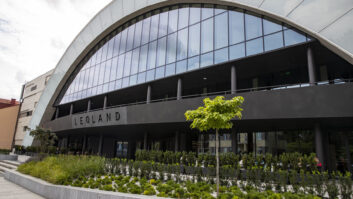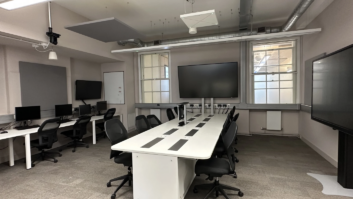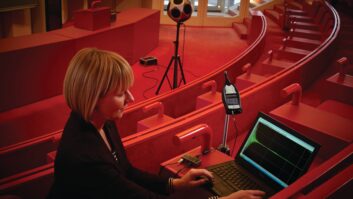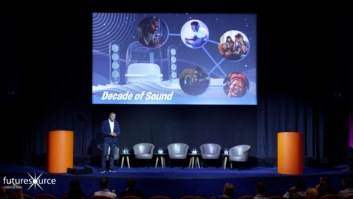Even before anyone had heard of coronavirus, the future of the office was a hot topic. What would it look like? How big would it be? Would people still go to a central building to do their jobs? And, less obviously but no less important, what would offices sound like? In the past eighteen months those questions have become more pertinent due to Covid dramatically disrupting work routines and practices, with many employees working from home. But as we all start returning to the workplace and a new hybrid way of working, it’s clear that audio has a bigger part to play than ever before – and the pandemic has changed everything.
“The state of the workplace market and the impact of Covid-19 are highly related,” says Alex Lepges, technical director for the EMEA region at Audio-Technica. “There has been a change in style, with more working from home and video conferencing using Microsoft Teams and Skype. This involves open-back headsets – which are popular in gaming – for online conferences but many companies are still holding meetings in their offices, using meeting rooms and huddle spaces.”
In these cases, Lepges says, there is demand for better sound quality. “People are looking for a variety of modern working styles, from small rooms to standing tables, rather than old fashioned furniture,” he comments. “In these cases the space above is important because a microphone can hang there without interfering with anything underneath but still pick everything up. The other end of the market, large public spaces and conference halls, is still a driving factor for our business with big discussion systems.”
James Hill, director of integrated systems at Shure UK, calls the current period “an interesting time for audio” because its value in meeting environments is at last being appreciated. “People are really starting to understand that audio is the single most important part of any meeting,” he says. “Whilst in the past people were drawn to large, colourful, beautiful images, it has become more obvious during the pandemic that these aren’t crucial to a meeting. It’s what people say that is important and not what can be seen on a screen.”
Hill observes that remote working had been discussed “for years” but never really happened. Now Covid-19 has forced the issue, companies are re-evaluating how office spaces work. “Meeting rooms are becoming bigger to allow for social distancing,” Hill says. “We’re working with a client who believes their staff have enjoyed looking directly at people on their video conferences rather than sitting three seats up from them in a meeting room and not being able to see their face. The biggest change we’re seeing is the desire for a touchless experience, such as microphones in ceilings, mounted on a wall or under a screen rather than having a handheld mic.”
TOUCH SENSITIVE
The advice to touch common surfaces as little as possible and so avoid infection has influenced how technical equipment, particularly microphones, is used now. “Users are apprehensive of shared devices,” comments Kai Tossing, head of product management for business communication at Sennheiser. “They have become used to the sight of mics in plastic wrappers and developed the uneasy feeling that viruses and germs may be hiding on mic bodies and windscreens.”
Because of this, Tossing says, there has been an increase in demand for more discrete systems that can be positioned away from people but still have the pick-up and coverage to produce good quality audio. Sennheiser’s offering for this applications is the TeamConnect Ceiling 2 (TCC 2), which is designed for both remote and on-site audio conferencing and satisfies the requirement of being touchless.
The system was updated in February with TruVoicelift firmware, designed to improve audibility. This provides extra gain, feedback prevention and background noise suppression. Sennheiser is also working with other companies to provide complete AV packages. “By entering into meaningful partnerships with other audio manufacturers and IT platform providers, we make sure that we can best support our customers’ workflows,” Tossing says.
Partners include Bose, which has combined the TCC 2 with its EdgeMax in-ceiling loudspeaker, DSP and amplification to create the ES1 Ceiling Audio Solution, which is certified for Teams and compatible with Zoom. At ISE 2020 Bose announced the VB1 video bar, which features six beam-steering microphones. It was originally scheduled for release in the summer of 2020, but only started shipping at the start of 2021 due to Covid delays.
TRANSITION TIME
Bose Professional’s director of emerging business and global head of work, Martin Bodley, observes there is a transition underway in the number of people attending meetings. “Rooms that normally would have held eight people will hold three,” he says. “There will be fewer 30 to 40 person meeting rooms and more five to six person spaces with two or three remotes coming in.”
Bodley also predicts that the rethink of workspaces will involve more repurposing of existing areas rather than new builds. “The whole reason for people going into the office is for face-to-face meetings,” he says. “But it might not be known what staff will be going in and when. Because of this an important area in the new world will be telemetry data gathering, which will indicate, among other things, if a room is at capacity.”
In audio terms, other technologies that are likely to play a role in redesigned workspaces include mic arrays, beam-steering devices, touchless operation and noise removal systems based on artificial intelligence (AI) and machine learning (ML). “AI and ML could be used to adapt not just incoming and outgoing audio but will be important in removing unrealistic or unwanted elements, such as background noise,” explains Bodley.
According to technology analysis consultancy Futuresource, unified communications and collaboration (UCC) systems have played a major role in enabling working from home during the pandemic. While the concept has been around for some time, the drastic changes demanded by the Covid crisis focused UCC use considerably.
Analyst James Kirby observes that in this context, audio has to be discussed alongside video, with a large number of integrated products now competing for market share. “In the meeting room, AV products such as video bars and tabletop systems have witnessed the highest levels of growth,” he says. “The market for audio in conferencing and the corporate sector has seen growth for some time, driven mostly by the increased use of cloud conferencing. There is a wide range of systems for this, from beam forming ceiling microphones and DSP units through to speakerphones and headsets at the individual user level.”
FUTURE TECH
One of the many manufacturers looking at future tech for the workplace is AtlasIED, which develops sound masking systems as well as loudspeakers and amplifiers. Vice president of marketing and corporate communications, Gina Sansivero, acknowledges that touchless working and increased use of personal devices will become more widely used. AtlasIED has also been working on updated features involving paging and sound notification for its existing products. Sansivero envisions such functionality being part of a next generation of offices as people return to work.
“We’ve been talking to a lot of corporate business contacts and they are looking for flexible workspaces where they don’t have to commit to a set way of working, so employees feel comfortable,” she says. There is the realisation, Sansivero adds, that workers may have become habituated to working from home and coming back into an office with other people – albeit probably not as many as before – could be a shock. “In those cases, noise cancelling will be imperative so that people can have private conversations and get on with their work,” she observes.
Sansivero continues that although there will have been background noise while people worked at home, it was a house environment and they were generally alone. At some point they have to get used to office noise again. “There will be a need for continuity, not just for business but also people’s mental health,” she comments. To ease people back in there might be more hoteling – where workspaces are booked in advance so that only a limited number of employees are in at any one time – but it is likely that different business will take different approaches.
OPEN SPACES
One such approach is the creation of open spaces and ‘pop-up offices’. Jabra, which produces consumer on-ear devices and headsets as well as professional audio and video systems for unified communications platforms, is exploring this in partnership with office space designer ROOM. The New York headquartered company, which also has several showrooms round the world, builds a variety of ‘rooms’ that are set up within a larger space. These use recycled plastic bottles for soundproofing and include the Phone Booth, the Meeting Room (which is enclosed), the Open Meeting Room (which isn’t) and the Focus Room, essentially a private office.
Jabra is providing its 4K PanaCast 180-degree camera for inclusion in the Meeting Room for videoconferencing. (The company introduced its new PanaCast 50 intelligent video bar and the PanaCast 20 intelligent personal camera – both specifically engineered for flexible working in the new normal – earlier this year. Both devices complement the existing original PanaCast camera.)
James Spencer, business development director for video at Jabra EMEA North, comments that because people are going into offices less frequently, there is a need to enhance the working environment. “The era of going to work five days a week is over,” he says. “People will now be expecting some kind of experience when they do go in. That can include headsets and there will be a need for portable audio, which can be plugged into a laptop, plus omni-directional microphones for good quality sound.”
There is also the possibility, Spencer adds, to create suitable working areas within larger spaces by using active noise cancelling technology. This could be in t
he form of headphones, enabling the wearer to block out any distracting noises around them. Acoustic treatments are also being employed to improve the sound of a room, with workspaces now a growing market. Audio-Technica has partnered with Portuguese company Artnovion, which produces a range of panels, tiles and baffles used in offices, homes and music applications, as well as, increasingly, working from home situations.
INTELLIGIBLE IMPERATIVE
Alex Lepges comments that intelligible audio is now imperative, not only for people to understand each other on conference calls but also because it reduces stress and fatigue among office workers. “If someone is listening to another person using a bad microphone or they’re in a poor sounding room, that can make the listener tired and even aggressive,” he says. “People need to use higher quality mics and have better sounding rooms.”
Even the smallest extraneous noise can disrupt a meeting, which is why many mics and other sensitive devices are shielded against RF interference from mobiles and other sources. Just block out the small talk and we’ll never look back to pre-hybrid work days.







